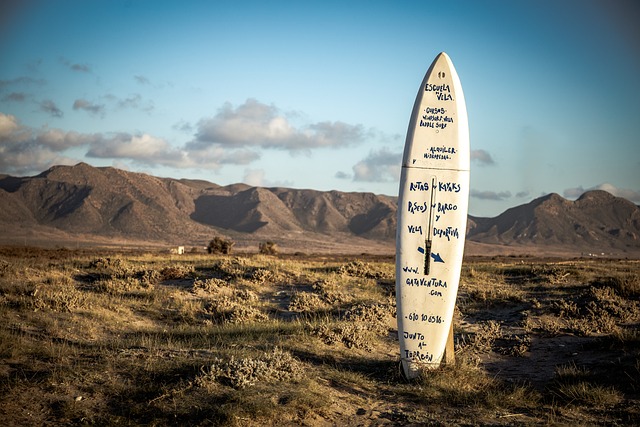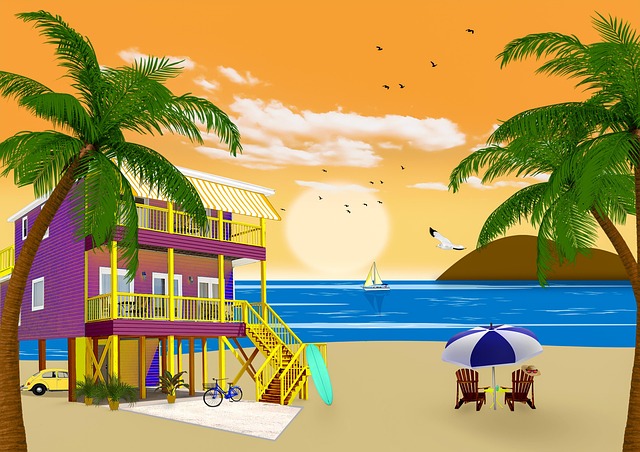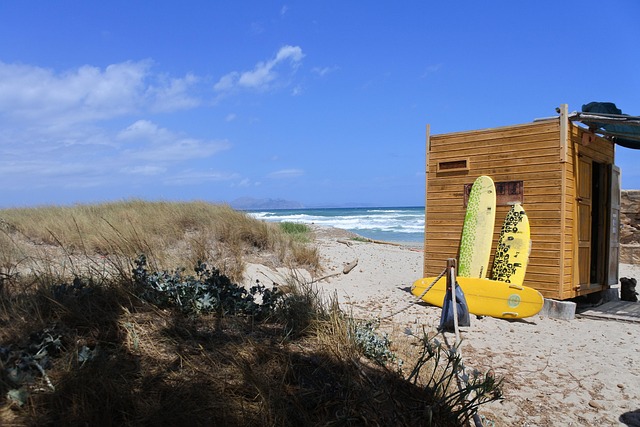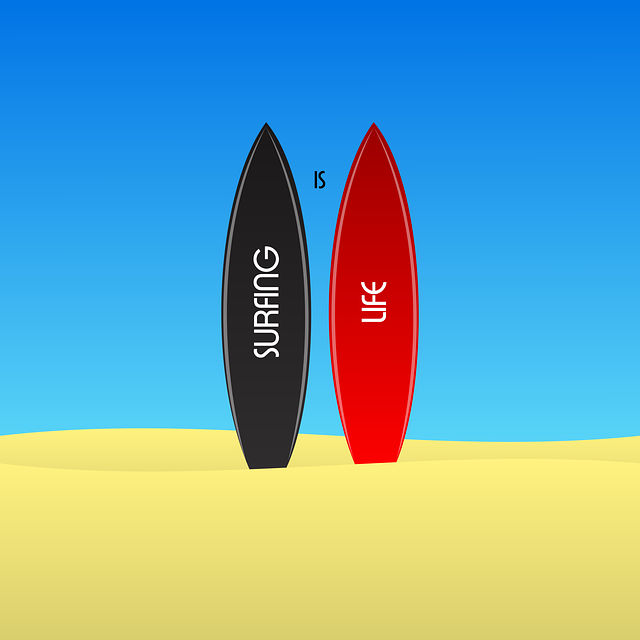Choosing the right surfboard as a beginner depends on your skill level, predominant surfing locations, and body type. Opt for shorter boards (5-7 feet) in calm waters and taller boards (8-10+ feet) for more powerful waves. Consider nose shape, tail design, flex, and width for stability, buoyancy, and maneuverability. Start with a slightly longer, wider board for confidence, then transition to performance-oriented models as skills advance.
Choosing a surfboard can be overwhelming, especially as a beginner. With various sizes available, understanding what suits your body type and skill level is key to an enjoyable surfing experience. This article guides you through the process, offering insights on selecting the perfect surfboard for beginners, from considering physical attributes to navigating water conditions. Learn about the benefits of different sizes, common mistakes to avoid, and expert tips to ensure a seamless entry into the world of surfing.
What to Consider When Choosing Your First Surfboard

When choosing your first surfboard, consider your skill level and where you’ll be surfing most often. For beginners, a shorter board like an 8-foot longboard or a 6-foot fish is ideal for learning to catch waves. These sizes offer stability and buoyancy, making it easier to stand up and paddle out to the break.
Additionally, look into the nose shape and tail design – rounded nosed boards are generally more buoyant and forgiving, while square-nosers can be faster and more maneuverable once you’ve mastered the basics. Choose a board with a soft or intermediate flex for added comfort during learning sessions. Remember, it’s better to start on a slightly longer, wider board that helps you build confidence than rush into something too performance-oriented before mastering the fundamentals of surfing.
Understanding Surfboard Sizes for Different Body Types

When it comes to choosing a surfboard, understanding your body type and skills is crucial. Surfboards come in various sizes, designed to cater to different heights, weights, and surfing abilities, making them ideal for both beginners and experienced surfers. For instance, shorter boards are great for smaller individuals or those new to surfing, as they offer better maneuverability and stability in the water. These boards typically range from 5 to 7 feet, allowing beginners to catch waves with relative ease.
On the other hand, taller surfers might prefer longer boards, often between 8 and 10 feet, which provide more buoyant volume, making them excellent for balancing and catching larger waves. Additionally, board width also varies, with wider boards offering stability and being suitable for beginners learning to paddle and catch waves. Narrower boards are more agile, preferred by skilled surfers who want to perform advanced maneuvers. Choosing the right surfboard size ensures a more enjoyable surfing experience, catering to individual needs and abilities.
Benefits of Smaller Surfboards for Beginners

Smaller surfboards are an excellent choice for beginners looking to dip their toes into the world of surfing. One of the key benefits is their maneuverability; shorter boards offer greater agility, making it easier for novices to turn and change direction on the waves. This improved control can boost confidence and make learning to stand and paddle much more manageable.
Additionally, smaller surfboards are generally lighter, which is advantageous for beginners who may struggle with the weight of a larger board. This reduced weight makes it simpler to lift and carry the board in and out of the water, as well as when traveling between locations. Such ease of use can encourage consistent practice and improve overall enjoyment of the sport.
Advantages of Larger Surfboards for New Surfers

For new surfers, choosing a surfboard is an exciting yet crucial step in their journey to riding waves. One factor that often gets overlooked but can significantly impact learning experiences is board size. Larger surfboards, typically measuring 9 to 12 feet (or even longer), offer several advantages for those just starting out.
Firstly, they provide stability and buoyancy, making it easier for beginners to stay on top of the board and catch waves. The increased surface area allows for better control and balance, reducing the risk of drowning or getting tired quickly. Moreover, larger boards tend to be more forgiving when paddling, helping surfers gain confidence as they learn to manoeuvre and stand up. This size is particularly beneficial in calmer waters where beginners can practice without being overwhelmed by too much speed or wave intensity.
Common Mistakes to Avoid When Selecting Board Size

When selecting a surfboard, especially as a beginner, it’s easy to fall into some common traps. One frequent mistake is assuming that larger boards are always better for stability and learning. While a longer board might provide more floatation, it can also be harder to maneuver, making learning turns challenging. For novices, a shorter board often offers better control and agility, enabling quicker learning curves.
Another blunder is neglecting your body type and skills. Some surfboards cater to specific skill levels or physical attributes. Beginners should look for boards designed for ease of use, with wider stances that provide stability. Ignoring these factors can lead to frustration and a less enjoyable learning experience. Always consider your height, weight, and comfort level when choosing a board size and shape suitable for your surfboard for beginners journey.
How Water Conditions Impact Surfboard Length Requirements

Water conditions play a significant role in determining the ideal surfboard length for both experienced surfers and beginners. For those new to surfing, choosing the right board is essential to make learning more accessible and enjoyable. In calm, gentle waves, shorter boards are often recommended for their maneuverability and ease of use. These boards typically range from 5 to 7 feet (1.5 to 2.1 meters) in length, making them versatile and suitable for various beginner settings like pools or small beach breaks.
In contrast, choppier or more powerful water conditions call for longer surfboards. For beginners tackling larger waves, boards between 8 and 10 feet (2.4 to 3 meters) can provide the stability needed to catch waves with confidence. Longer boards offer better glide and wave-riding capabilities, making them ideal for building skills in more challenging conditions commonly found at intermediate surfing spots.
Top Picks: Best Surfboards for Beginners by Size

When it comes to choosing a surfboard for beginners, size matters. For those new to the sport, a board that’s too long or wide can make learning difficult and even discourage progress. That’s why selecting the right beginner surfboard by size is a crucial first step.
Top picks in this category usually fall between 6-8 feet in length. These mid-sized boards offer the best balance of stability for beginners to catch waves consistently, while still being maneuverable enough to learn essential turns and maneuvers. Look for boards with a rounded nose and medium rockers for smoother rides and easier turning.
Tips for Testing and Adjusting Your Surfboard Fit

When choosing a surfboard, one of the most crucial aspects is ensuring it fits your size and skill level, especially if you’re a beginner. Testing and adjusting your surfboard fit can greatly impact your overall surfing experience. Start by measuring your height and weight to get a basic idea of which board size might be suitable for you. Many surfboard manufacturers provide size charts that offer guidance based on body dimensions. However, it’s essential to keep in mind that everyone surfs a bit differently, so these charts are just a starting point.
To truly find the perfect fit, consider renting or borrowing boards of various sizes and shapes to get hands-on experience. Hit the beach or surf pool and try out different boards, noting how each feels when paddling, turning, and catching waves. Pay attention to your comfort level, stability, and ability to maneuver. Adjusting the fins or changing the board’s stance can also fine-tune the fit. Don’t be afraid to ask experienced surfers for advice; they often have valuable insights on what works best for different body types and skill levels, especially when it comes to a surfboard for beginners.
Growing with Your Surfboard: Long-Term Size Considerations

When choosing a surfboard, selecting the right size is crucial, especially if you’re a beginner. It’s not just about finding something that floats; it’s about matching your board to your skill level and physique. For newcomers to surfing, it’s recommended to start with a longer board, often 8-10 feet, as these offer stability and make catching waves easier. Longer boards are more forgiving, allowing beginners to focus on learning techniques without worrying about rapid speed or hard turns.
As you gain experience and improve your skills, you might want to consider shorter boards, typically under 7 feet. These offer enhanced maneuverability and acceleration, making them ideal for performing tricks and navigating tight spots in the water. However, these smaller surfboards require a higher level of proficiency to control effectively. Thus, growing with your surfboard involves understanding that choices should align with both current skill sets and future goals, ensuring an enjoyable and progressive surfing experience.
